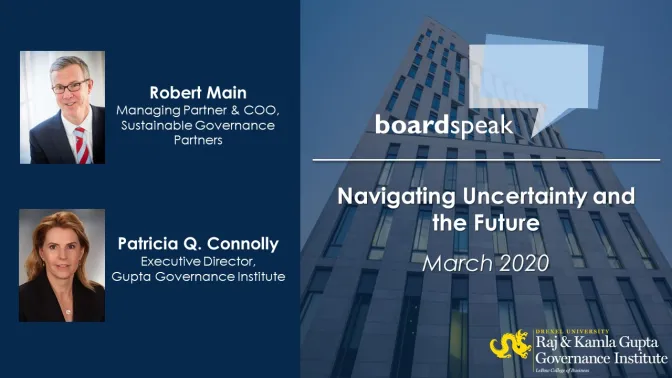
Shareholder Engagement: An Evolving Landscape
One practice that has changed considerably over the past few years is shareholder engagement. Shareholder engagement is a contentious topic. Experts say it’s a key practice for boards to engage directly with shareholders, but not all boardrooms and CEOs share that view. Dan Pliskin, Associate Partner at Aon Hewitt, has been actively engaged in the corporate governance community for many years. He has served as in-house corporate governance counsel and now advises corporations on a wide range of governance topics. Executive Director of the Gupta Governance Institute, Patricia Q. Connolly, sat down with Dan to discuss his views on a variety of shareholder engagement issues.
Patricia Connolly: In reviewing Larry Fink’s 2018 letter to CEOs, Bill McNabb’s 2017 letter to CEOs, and the Commonsense Governance Principles, there is encouragement for boards to increase shareholder engagement. Can you share your view on where we are today on the spectrum of shareholder engagement and where we are headed?
Dan Pliskin: As is the case with many corporate governance practices, shareholder engagement was first done at large cap companies, which are further down the road in conducting regular and robust engagement with investors and proxy advisors. Some small cap companies, on the other hand, do not yet have programs that are as fully developed, given they do not have the same resources that larger companies do, and sometimes it can be more difficult for them to get an audience with shareholders. Some smaller companies might also be more focused on first developing relationships with portfolio managers or analysts, who are a separate audience from proxy voting groups at shareholders.
Even though many small cap companies may not have fully built-out shareholder engagement programs, if you don’t get the necessary support on issues like say on pay, engagement is still mandated by ISS and Glass Lewis. Small cap companies are then forced to figure out engagement quickly, and get up the learning curve. So, engagement is happening at all levels, it’s just a matter of whether it’s an activity the company engages in proactively, or reactively.
“So, engagement is happening at all levels, it’s just a matter of whether it’s an activity the company engages in proactively, or reactively.”
Connolly: Statistics from Edelman show that shareholders trust external sources of information more than CEO or Board – what does this say about the effectiveness or quality of shareholder engagement?
Pliskin: Some investors view the board as agents and advocates of the company, rather than of its shareholders. This view is relatively consistent with Edelman’s findings. A company needs to have credibility with its shareholders; that credibility is a precious asset. While the company cannot completely control shareholder perceptions, the board and management can enhance their reputations by maintaining an honest and forthright relationship with shareholders. Communication and engagement are the keys to establishing trust. Companies can build credibility over time by providing their shareholders with reliable information.
Management teams are under a lot of pressure to succeed, and to produce results. No management team wants to be in the position where they are forced to say to their shareholders, “we are not going to perform as well as we thought this quarter.” But being transparent about those types of situations can build relationships and trust with shareholders. Investors seek a relationship of trust with management and the board, so it’s in the board’s best interest to establish that trust.
There is one caveat to consider when looking at the Edelman survey, and that is the fact that Edelman surveyed portfolio managers, researchers, and analysts, rather than governance specialists at institutional investors. So, the population that was surveyed may be more skeptical, and results might have been different if they had surveyed proxy voting and governance teams.
Connolly: Some companies argue they do not engage with shareholders as to not violate Regulation FD. Is this a valid argument, and if so how can boards make sure they don’t violate Reg FD?
Pliskin: There is a distinction between engagement and disclosure. These are two separate concepts, and they directly relate to the potential violation of Regulation FD. Engagement is a two-way street: shareholders give their perspective on the company’s governance, and directors and management articulate strategy, perspective and approach to shareholders. Separately, disclosure is unilateral: it’s the release of information by the company to the public, including Wall Street. Shareholder engagement is meant to be a dialogue and create that two-way street that complements disclosure. Boards would be well-served to distinguish between the two to understand that some engagement is essential to the company’s success.
“Engagement is an important part of the investment decision process.”
Investors are increasingly viewing the refusal of a board to engage with a shareholder as a “cop out.” Investors can tell when directors use the risk of a potential violation of Reg FD as a shield. Most shareholders are not looking to gain inside information through engagement, or have a “gotcha!” moment with the board. They are simply looking to directly understand the strategy behind the action the company is taking. Not engaging with your owners is not going to be viewed well by shareholders, because trust begins by being willing to have those interactions.
Companies can provide their directors and managers with training to protect against the potential violation of Reg FD while engaging with shareholders. They can train staff to avoid violations, and make sure that directors and managers are up-to-date on the latest authority.
Connolly: Tom Manny, CEO of Dun & Bradstreet, has said that activism starts with a perceived board weakness. How does shareholder engagement play a role in helping boards communicate their strengths and establish trust with shareholders?
Pliskin: Shareholder engagement can play a huge role in helping boards to communicate their strengths and establish trust with shareholders. Being forthcoming with shareholders and engaging on all matters, not just the positive ones, will foster an environment in which shareholders develop trust in the board and management. Shareholders can develop confidence in the abilities of the board through getting to know them, having a relationship with them and utilizing them as a resource.
For example, if you are part of the S&P 500 Index, the Vanguard S&P 500 Index Fund owns you; there is no choice there. However, there’s a benefit to both your board and the shareholders from engagement. Vanguard is presented with the opportunity to interact with and establish a relationship with your board, and your company is presented with the opportunity to articulate the reasons behind decisions on issues like executive compensation or governance structure, because the established relationship means a true dialogue can occur.
Companies should begin to proactively establish a relationship with shareholders, and work to establish trust through communication. It is not optimal to start the first conversation with shareholders when the company needs something from them. The same holds true for ISS and Glass Lewis; it is beneficial for directors and management to reach out and initiate dialogue, rather than waiting to reach out when there is an issue or disagreement.
Having relationships with the governance teams at institutional investors can especially aid the board in the long-term. Activists are increasingly going to institutional investors, along with big mutual funds and pension funds, in search of support for their agenda. Institutional investors often align with activists; however, that changes when they have a relationship with the board or management. Institutional investors are more likely to give management a chance to express its views when they have an established relationship with them, and often give management more leeway by drawing on past experience. They can then say, “I talked to this director and I believe that they know what they’re doing, and they anticipated this blip.”
Connolly: Is there a difference in how and how often you engage with different shareholders (i.e. index funds, institutional shareholders, activist shareholders)?
Pliskin: Absolutely, there are different forms of engagement for different shareholders. It’s important to tailor engagement to your audience. Boards need to do their homework and know their audience and that audience’s profile and policies.
For instance, institutional investors will likely have their own voting policies. Directors cannot go into meetings unprepared on those policies. Also, directors need to be prepared to engage on the full range of topics, as shareholders could come in wanting to talk about anything. Directors should do as much planning as possible before engaging and know what they are walking into. Similarly, for ISS and Glass Lewis, directors need to understand their outlook and policies. Nominally, they are proxy advisors, but they view themselves, in some ways, as a surrogate shareholder, in part because many investors vote in accordance with their policies, so it’s critical to engage with them as such. Other types of investors may also have different views that you must know of and adhere to. Hedge funds may have a different type of investment goal than an index fund, or foreign investors may have completely different views on policies.
Connolly: Can you share any examples of positive and/or negative impacts of director involvement, or lack of involvement?
Pliskin: One example of the positive impact of director involvement comes from a company we were advising during the off-season, going into this year’s proxy season. The company had reached out to its shareholders and had indicated that a member of the company’s compensation committee could participate, and this director joined the call. That director’s understanding of the company’s strategy and transformation had a positive impact on gaining the support of shareholders on the company’s “say-on-pay” proposal. That director’s strong interpersonal skills gave the shareholders the reassurance they needed. Shareholders had a greater understanding of their investment in the company because of their positive interaction with this director.
On the other hand, if directors are unprepared and attempt to “wing” a meeting with a shareholder, it can have a very negative impact. Investors are savvy, and they pretty much see right through this. Investors may walk away from these conversations with a negative view of the board and management, and decreased confidence in the company’s performance.
Connolly: Where do you see shareholder engagement in three years? What do you anticipate the future state of this space looking like?
Pliskin: In my opinion, governance is only going to grow in importance. Boards would be well-served to be aware of governance trends and practices, as well as understand their own practices, and to affirmatively take matters into their own hands. You don’t want to let an activist be the one to point out issues in your policies. Companies and boards will be far better off if they are proactive, prepared, and understand where their vulnerabilities lie.

